Watershed approach provides baseline condition of all of Minnesota’s 80 Watersheds
On May 8, 2023, the Minnesota Pollution Control Agency (MPCA) put on public notice the Total Maximum Daily Load (TMDL) report and Watershed Restoration and Protection Strategy (WRAPS) for the Blue Earth Watershed – marking the completion of monitoring and assessment of all 80 watersheds in the state of Minnesota.
The Clean Water Act established the framework for creating water quality standards and safeguarding water for drinking, swimming, and fishing. This act requires the MPCA to report impaired waters that don’t meet the standards. In 2008, Minnesota passed the Clean Water Legacy Act which requires the development and updating of Watershed Restoration and Protection Strategies (WRAPS) reports for every watershed in the state. A WRAPS report summarizes all the technical information to support the implementation of restoration and protection projects by local partners. Minnesota’s Clean Water Legacy Fund provides authority, direction, and resources to achieve and maintain water quality standards. Funds are used for water management activities such as monitoring, watershed characterization and scientific study, planning, and on-the-ground restoration and protection activities.
Instead of reviewing each stream or lake individually, the State of Minnesota developed a watershed approach to focus holistically on each watershed’s condition as the scientific basis of permitting, planning, implementation, and measurement of results. This process looks strategically at the entire drainage area of a watershed which increases effectiveness and efficiency, and is tailored to meet local conditions and needs, based on factors such as watershed size, landscape diversity, and geographic complexity.
Since 2008, each of Minnesota’s 80 major watersheds have been evaluated to show trends in water quality and the impact of any restoration or protection actions. To identify and address threats to water quality in each watershed, WRAPS reports address both strategies for restoration for impaired waters, and strategies for protection for waters that are not impaired. Waters not meeting state standards are listed as impaired and total maximum daily load (TMDL) studies are developed for them. The TMDLs are incorporated into the WRAPS reports. To date, the MPCA has completed 1,937 TMDLs.
Because of this strategic watershed approach, the MPCA and other agencies have developed strong foundational science on many water quality standards. While in a water rich state, it is difficult to evaluate every waterbody, every watershed will continue to be monitored and assessed every 10 years to strengthen the state’s protection and restoration efforts.
Learn more here: https://www.pca.state.mn.us/air-water-land-climate/watershed-approach-to-water-quality
